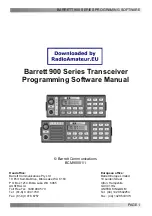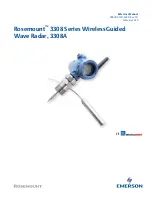
October 26, 2007
6880309U09-A
3-4
Basic Theory of Operation
: Analog Mode of Operation
3.5
Analog Mode of Operation
3.5.1
General
Reception and transmission are switched by “RX” and “TX” lines from the microprocessor unit
(MPU). The receiver uses a double-conversion superheterodyne circuitry, with a 17.7 MHz 1st IF and
450 kHz 2nd IF. The 1st LO, which is produced by a PLL synthesizer, yields the 17.7 MHz 1st IF.
The 2nd LO uses a 17.25 MHz (17.7 MHz – 450 kHz) signal generated by a crystal oscillator.
The 2nd mixer and other circuits use a custom IC to convert and amplify the 2nd IF, and detect FM to
obtain demodulated signals. During transmitting, the PLL synthesizer oscillates at the desired
frequency directly, for amplification to obtain RF power output. Voice modulation and CTCSS (or
DCS) modulation are also applied to this synthesizer when the radio is transmitting. Transceiver
functions, such as TX/RX control, PLL synthesizer settings, and channel programming, are
controlled using the MPU.
3.5.2
Receive Operation
Receiver
Incoming RF signals from the antenna connector are delivered to the PA Unit, and pass through a
low-pass filter (LPF) network consisting of coils L6011, L6010, and L6009, capacitors C6047, C6045,
C6044, C6075, C6043, C6042 and C6074, and antenna switching relay RL6001 for delivery to the
receiver front end in the MAIN Unit.
Signals within the frequency range of the transceiver are then passed through a varactor-tuned
band-pass filter consisting of T1001/T1002/T1003 and T1004 before RF amplification by Q1006
(
GN010100R
).
The amplified RF is then band-pass filtered again by varactor-tuned resonators T1001, T1002,
T1003 and T1004 to ensure pure in-band input to the 1st mixer 1040 (
SPM5001
).
Buffered output from the VCO Unit is amplified by Q1021 (
2SC5107
) and low-pass filtered by L1030,
L1020 and C1161, C1152, C1143 to provide a pure 1st local signal between 54.7 and 67.7 MHz for
input to the 1st mixer.
The 17.7 MHz 1st mixer product then passes through dual monolithic crystal filters XF1001 and
XF1002 (12 kHz BW), and is amplified by Q1035 (
2SC4215
) and delivered to the input of the FM IF
subsystem IC Q1034 (
TA31136FN
). This IC contains the 2nd mixer, 2nd local oscillator, limiter
amplifier, FM detector, noise amplifier, and squelch gate.
The 2nd LO in the IF-IC is produced from crystal X1001 (17.25 MHz), and the 1st IF is converted to
450 kHz by the 2nd mixer and stripped of unwanted components by ceramic filter CF1001. After
passing through a limiter amplifier, the signal is demodulated by the FM detector.
Demodulated receive audio from the IF-IC is amplified by Q2019 (
CXA1846N
). After volume
adjustment by the AF power amplifier Q2018 (
TDA7240AV
), the audio signal is passed to the
speaker jack or the internal 4-Ohm loudspeaker.
Summary of Contents for PM1200
Page 1: ......
Page 2: ......
Page 6: ...iv Notes ...
Page 30: ...October 26 2007 6880309U09 A 2 4 Basic Maintenance Handling Precautions Notes ...
Page 38: ...October 26 2007 6880309U09 A Notes 3 8 Basic Theory of Operation PLL Synthesizer ...
Page 108: ...October 26 2007 6880309U09 A Notes 7 4 Basic Troubleshooting Receiver Troubleshooting ...
Page 134: ...October 26 2007 6880309U09 A Glossary 8 Notes ...
Page 137: ......
















































